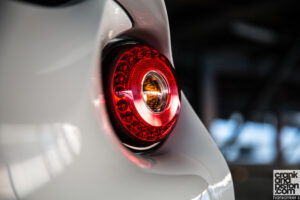REVIEW. Lotus Evora 400
Reviews | crankandpiston.com / EVO Middle East
Does the fastest Evora yet truly offer ‘supercar performance’?
Originally posted – 14 February, 2016 | crankandpiston.com | EVO Middle East magazine (PDF)
My time with the Lotus Evora 400 is almost ruinously short, as this particular marketing vehicle has been only retained briefly in town by local dealer Al Futtaim and is intended for promotional purposes, rather than test-drives. In fact, having picked up the car from the showroom, we only have until 6pm tonight before we need to drop it back again.
Hence you find me on one of my regular haunts around CnP GHQ, a 5km loop encompassing fast switchbacks, long sweepers and the occasional sprawl of mid-afternoon traffic. The opening stretch in particular is one of my favourites: a long-sweeping left hander through one of the nearby underpasses, through which it’s customary to give several flicks of the left wrist, bring the gears down, the revs up, and listen to whichever engine we happen to be testing sing.
Okay, here we go…
…wait…what the hell was that?
I hadn’t expected that. After all, beneath the aggressively sculpted bodywork of the Evora 400 is a 3.5-litre turbocharged V6, pushing 400bhp and 302lb ft of torque, and thus capable of a little under 300kph. Gutsy then, certainly. And yet the high-pitched tones reverberating from the back end, reminiscent more of a slightly muffled Ferrari V8, is a far cry from the more rorty V6 timbre I’d been expecting.
Are my ears playing tricks on me? Perhaps, and since I’m nothing if not thorough (stop laughing), I swing the nose around for another run, windows down. That same beautifully ornate noise once again rattles both the tunnel walls and the hairs on the back of my neck at barely over 4000rpm.
What is going on?
Though essentially an Evora S at the base, Lotus’ newest plaything has received some serious tweaks to produce, what the company calls, its ‘fastest road car of the new millennium’. Indeed, two thirds of the lighter, more powerful 400 is brand-new, including a more structurally rigid chassis, new suspension geometry, larger AP Racing brakes, lightweight seats, and updated aero courtesy of a three-part rear spoiler, five-blade airflow diffuser, and aggressively raked front air intakes. Combined, it’s a recipe for one of the most potent Lotuses yet. Or, as Lotus itself puts it, ‘supercar performance.’ The noise alone suggests this is not just preamble.
At the next roundabout shortly after the tunnel run, I make another U-turn, relieved to find Lotus’ beautifully detailed steering feel still intact. With the brand’s previous electronic power steering given the elbow, there’s considerably more physicality required under turn-in, but superbly textured feedback means there’s a much greater sense of engagement when loading up the front end. Revised dampers ensure composure is similarly sublime.
What’s surprising me through is the underlying sense of aggression, a factor we rarely see from Lotus. From standstill, acceleration is seriously punchy, 0-100kph taken care of in a shade over four seconds. But it’s the traction out of the tighter corners that really impresses: so keen is the 400 to put its power down that the front end can be ushered into understeer on occasion. Feathering the throttle tucks the nose back in, allowing the tail to swing, and we’re back into that Ferrari-esque soundtrack within seconds.
Not that this scintillating experience is without its faults, however. Sliding into the cabin is far easier than a standard Evora thanks to considerably slashed side sills, but head and legroom is still at a premium. Sublime poise and aggressively tinged acceleration will set you back the same deposit you’d fork over for a Porsche 911 Carrera, which is hardly an unyielding truck in itself.
Most grating of all though is the six-speed automatic gearbox. We have taken issue with Lotus’ transmission in the past, it offering neither the same slick changes nor engagement as its manual alternative. Sadly, much is the same with the Evora 400. Upshifts are crisp and rapid, but downshifts are considerably more finicky. Surprisingly physical steering we can accept and applaud, but the weighty ‘ker-chunk’ you get when changing gear is another matter.
Lined up for yet another run through the tunnel, the Evora 400 is already straining at the bit. Purists may argue that the 400’s innate aggression corrupts Lotus’ decades-born philosophy, but the results speak for themselves. As ever the company has produced a car utterly spectacular through the corners, spell-binding to listen to, and a driving experience more engaging than more prestigious rivals could dream of. Even if the slightly truculent automatic gearbox weighs that down a bit.
Now, if you don’t mind, the tunnel is in sight…
Images | Awesome Group and Harisanker S
Reviews | crankandpiston.com / EVO Middle East | James Gent














